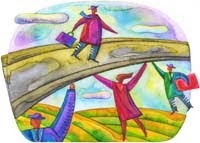The first five in a series of related documentaries has been posted there, 6-15 minute tales beautifully shot and edited that you should stop and watch right now.
I highly recommend the one focusing on Joel Bukiewicz of Cut Brooklyn. Having obtained an MFA in fiction-writing, but facing difficulties with getting his first manuscript published, he began to fear he would lose writing, something he deeply loved, and he decided to take a step back from the anxieties and fears that were beginning to intrude upon it: he took a three month hiatus. During that time, he discovered a need to make "creative offerings" on a daily basis, to make or fix things. Every day. So he began to do small jobs--making shelves or cabinets or fixing what was broken. He thought it would be interesting to try to make a knife, and when he tried it, he found the process really resonated with him. He like making something basic and useful, something not abstract. He started out in the backyard "dilapidated garden shed:"
"You go into the shop, and, you know, you cut yourself, you burn yourself, you fuck stuff up, you...ruin something you've worked on for...three weeks and you never make that mistake again. So this is how I learned."
Another one you can't go without seeing documents the story of Ezra Caldwell of Fast Boy Cycles. He was studying Industrial Design, and found that he wasn't as excited about styrofoam and computers as he was about the idea of design. One night, a friend dared him to take a dance class, and he came out of it exhilarated, and went the next day to his university's dance department to change majors. When they asked him if he'd ever danced before, he said, "Yeah, I took a class last night!" Amazingly, things worked out well, and he was soon being paid to teach dance, but he had already pretty much lost interest.
While he was teaching, he was using his bike to get everywhere, and per the requests of students and others around him, he began finding bikes and tweaking them to fit certain types of needs, styling them for people, and he finally decided he wanted to make the thing by hand from start to finish, he wanted to put the effort in and like what he made at the end, and it wasn't happening with dance, and so he just quit. He called it a "Leap and the bridge will appear moment."
One year into making bikes, he was diagnosed with rectal cancer, and his doctor told him, no more riding bikes. He was stunned. He went back the next day and asked if this was an issue of exertion, of too much exercise, but the doctor said no--exercise is great, but you've got a tumor right there; I don't want you on a bicycle seat. At all.
So Ezra said, "What if I build a bike with no seat?"
And so he did:


















